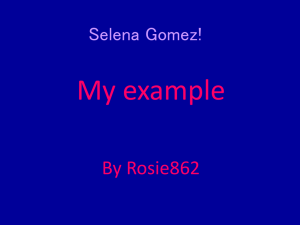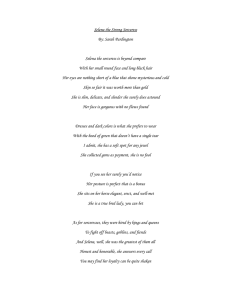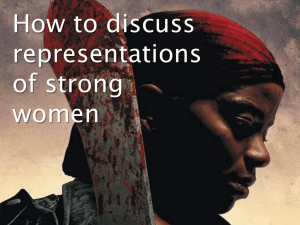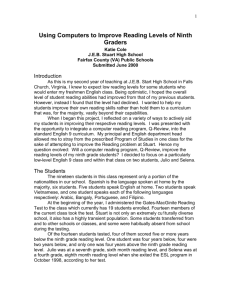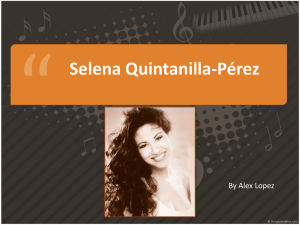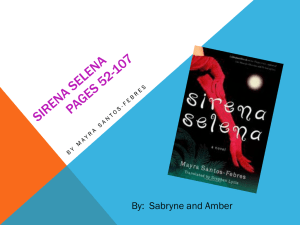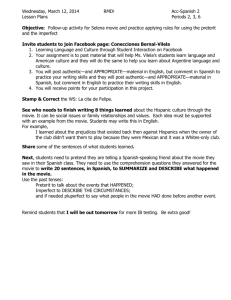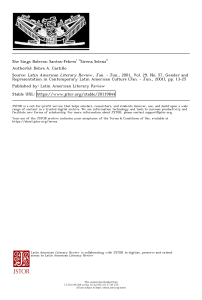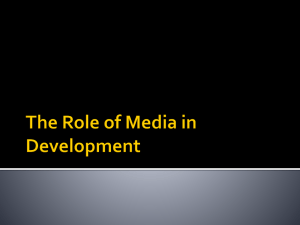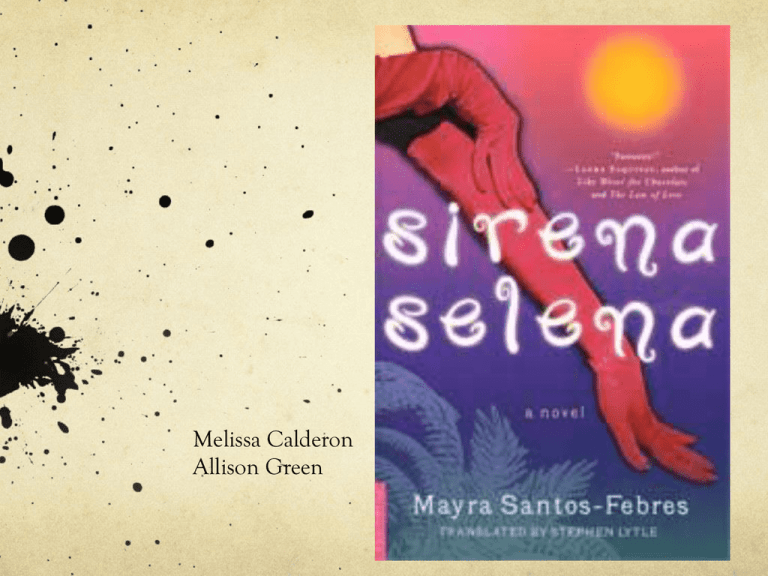
Melissa Calderon
Allison Green
Mayra Santos-Febres
Born in Carolina, Puerto Rico 1966
Novelist, poet, Essayist, Professor at UPR, Río
Piedras (Humanities Department)
Receives PhD from Cornell University and poetry
collections well received 1991
Anamú y manigua
El orden escapada
Juan Rulfo Award for short story “Oso Blanco”
1996
Discusses many of same themes throughout
“Sirena Selena”
Sirena Selena 2000
First novel
Highly successful (subsequently translated
into English)
Finalist for 2001 Rómulo Gallego’s Prize for
the Novel
PEN Club of Puerto Rico Prize for Best Novel
Author's Blog
Caribbean Social Climate
Puerto Rico
Commonwealth of United States
Early 2000’s poverty rate on island
aprx 45%
1999 median income $14,412
58% of Puerto Rican children live
below poverty line
Highest in rural areas
3x higher than in the United States
Declining family population
Migration to mainland
27% families with children female
runs the household
Prevalent practice of grandparents
as primary caregivers
Caribbean Social Climate
Dominican Republic
Highly stratified social classes
Tiny upper class, medium middle class, massive working class
Majority of “working class” lives in absolute poverty
Santo Domingo one of poorest areas in country
1/3 people 15-24 are unemployed
Illicit drugs
High prostitution rate per capita
Technically legal practice in DR
Human trafficking
Source/transit/destination country for commercial sex and labor
trafficking
Men, women, children
Government does not comply with minimum standards for
“elimination of trafficking victims”
Main Characters
Sirena Selena
15 years old
Gay/transvestite
Prostitute
Boleros, “sings like the angels in heaven”
Only family was his Abuela but she died
Martha Divine
Drag Queen/transvestite
Owns the “Blue Danube”
Businesswoman
Was once married
Breast implants, hormones
“rest in single body”
“liberate worst fears”
Retired performer
Selena’s mentor and “mother figure”
Main Characters (cont)
Leocadio
Side story
Life parallels with Selena’s
Poor family
“Different” from other boys, “delicate”
Hugo Graubel
Rich and successful
Unhappy marriage
Infatuated with Selena
Schemer
Main Characters (cont.)
Solange
Wife of Hugo
Has three children, back to back
Lonely
Passive, “handling my rear end…pretend not to notice”
“Everything must be perfect”
“Hugo will realize what he has at his side”
Valentina Frenesi
Met Selena while prostituting
Took Selena in and acted as “big sister”
Drugs
Protector
Caring
Key Plot Developments
Traveling to Dominican Republic for business
Federal laws prohibit child labor…we’ll go to Dominican Republic, where they
don’t care about such things.”
Selena and Hugo meet at the audition for the hotel
Selena gets offered a job to perform privately for a party
She accepts, leaves Martha a note and leaves
Wants to prove self to Martha, independent and businesswoman
Introduced to Leocadio as a side story
Valentina
Selena meets her “first mother” but more like an older sister
Takes Selena in when she finds out she is homeless
Selena is gone for hours one night while prostituting
Valentina finds her all bloodied up
In hospital for days, runs from Social Services
Valentina takes care of her
Chapter on Solange
Plot: Context of Homosexuality
“Even at the Beach those men would not leave him alone. He
didn’t know how they found him, how they tracked him down
everywhere, how they saw something in him…” (40)
“Well, her father was angry as the devil, but her mother and
aunts defended her: ‘Don’t you see, Damaso, he’s just playing
theater. Leave the boy alone, he doesn’t mean any harm.’ The
father kept grumbling from the balcony. ‘You keep on laughing
at how cute the boy is, but don’t come crying to me when you
have to face the consequences.’ He must have had some idea of
what was to come…You know how parents are.” (23)
“But that’s the way it’s been from early on. He was born that
way, I’m sure of it. Maybe because he grew up without a
father…I don’t know what this child has that makes men crazy.
They follow him...” (57)
Transvestitism: Drag as a Metaphor
Santos-Febres: “Cities are transvestites dressed up to look like
First World, taking on gestures and habits that do no belong to
them in order to try and “escape” their reality and move closer
to something that just gets further and further away: progress
and civilization”
Transvestites (i.e. Sirena Selena) as a metaphor for volatile
Caribbean social climate
“A Caribbean loca trying to be something else. We all wanted to
be something else, to be somewhere else, Studio 54, Xenon,
walking down Fifth Avenue in Manhattan without anyone
noticing the dark blotches from the mosquito bites on our legs.
The thing was always about denying our miserable reality, to
disguise it with … glitter. Or, better still, to invent a new past,
dress ourselves up to the hilt, head out, and be someone new,
among the spotlights and the dry ice, mirrors and strings of
lights, to start out fresh, newly born” (pg. 20-21)
Transvestitism: Drag and Gender Identity
A combination of the monstrous and beautiful
“If they felt somewhere between frightened and seduced, between dying for more and crazy to get
away from that overwhelming gaze, then success would be hers and Selena’s, she felt it, success,
money, and respect for both of them, for her Miss Martha Divine, who deserved it so utterly (pg.
28)
“Loca, that’s not where a young lady is supposed to have her first period” (pg 7)
“Oh yes, her body, this disguise that was her body. She trembled just thinking that
someone, in the middle of takeoff, might point a finger at her and shout, “Look at that.
That is not a woman.” And they would turn the aircraft around and force her from it,
throwing her suitcases to the ground. Her bags would open, suddenly spewing high heels,
gauze and tape, depilatory creams, and thousands of other cosmetic items, lending
themselves, the bitches, as evidence. The captain himself would deplane to insist that she
had no right to enjoy the comfort, the airborne luxury, the dream of raveling to other
shores. Not her, she’s an imposter.” (pg. 13)
Interchangeable use of masculine and feminine identity terms
Importance of “operation” for Martha
Transvestitism: Conflict with Traditional
Masculinity
Undermines traditional masculine ideals (i.e. power and strength)
Physical manifestation of “war against nature”
Use of makeup (pg. 28)
Ritual of binding genitalia for drag
Humiliating or empowering?
Homoerotic
“It’s not that Sirena wanted to boast, but she had enough down there to share and
then some. Every time they got to this point Miss Martha laughed and said, “Ah,
mija, I can’t wait for you to start taking hormones to see if that thing shrinks a
little, “I’m going to have to start charging you more, to cover the cost of extra
tape.” … “Sirena’s penis was immense, a little grotesque because it was so
disproportionate to the rest of her body. If Martha hadn’t been looking at it
through the eyes of a mother and a businesswoman, she would not have hesitated
to find a place to put that hunk of meat, just to satisfy her curiosity about feeling it
inside, in all its magnitude” (pg 30).
Musical Influence
La Lupe
Born in Santiago de Cuba,
December 23,1939
Died in the Bronx, NY 29
February 1992
Cuban-American singer of
several musical genres
including boleros, but more
salsa
Active 1958–1980
Bolero
Musical Influence (cont.)
Sylvia Rexach
Bolero
Jan 22, 1922 – Oct 20, 1961
Singer and composer of boleros
Boleros
“one of the great traditional forms of
the love song, the bolero.”
"Boleros are love songs at their core,
but they are so much more. They
deal in death, religion, despair, hope
and la lucha: the struggle of living."
Sources
Santos-Febres, Mayra, and Stephen A. Lytle. Sirena Selena. New York: Picador USA, 2000. Print.
http://as.americas-society.org/files/images/event_622.jpg
http://repeatingislands.files.wordpress.com/2009/07/sirena21.jpg?w=500
http://www.gf.org/fellows/16676-mayra-santos-febres
http://www.yourchildlearns.com/online-atlas/images/dominican-republic-map.gif
http://www.nationsencyclopedia.com/economies/Americas/Dominican-Republic-POVERTY-ANDWEALTH.html
http://www.topuertorico.org/economy.shtml
http://www.prb.org/pdf/childreninpuertorico_eng.pdf
http://gocaribbean.about.com/od/healthandsafety/a/Caribbeansex_2.htm
https://www.cia.gov/library/publications/the-world-factbook/geos/dr.html
http://books.google.com/books?id=l0KA5n4Gm9UC&pg=PA104&lpg=PA104&dq=transvestites+%
2B+caribbean+culture&source=bl&ots=OK0WrXl5uR&sig=07vcW3l7tGU6TIY_SPd3t6iksaI&hl=en&sa
=X&ei=bXyVT8fXI6Gf6QHzq7nYCw&ved=0CFUQ6AEwAw#v=onepage&q=transvestites%20%2B%20
caribbean%20culture&f=false
http://en.wikipedia.org/wiki/La_Lupe
http://en.wikipedia.org/wiki/Sylvia_Rexach
http://www.npr.org/2012/02/05/146398291/the-romantic-and-still-relevant-sound-of-bolero
http://www.youtube.com/watch?v=v81W-MwG9U8
http://www.youtube.com/watch?v=1Z5OU03AviU&feature=relmfu


